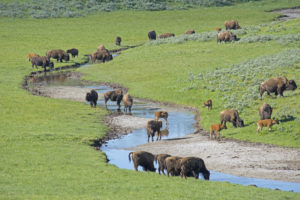
This month, let’s take a journey out west to the state of Montana. It is the 43rd most populous and the 4th most extensive in land area of the 50 states. It is the largest landlocked U.S. State. It is slightly larger than Japan. It is the 4th largest state in the United States after Alaska, Texas and California.
The state has several nicknames, although none of them are official. They include “Big Sky Country” and the “Treasure State.” The state’s slogans include “Land of the Shining Mountains” and “The Last Best Place.”
The western half of Montana contains numerous mountain ranges. Smaller island ranges are found throughout the state. In all, 77 named ranges are part of the Rocky Mountains. The eastern half of Montana is characterized by western prairie terrain and badlands.
Business Climate
The economy is primarily based on agriculture, including ranching and cereal grain farming. Other significant economic resources include mineral extraction such as oil, gas, coal, hard rock mining, and lumber. The health care, service, and government sectors also are significant to the state’s economy.
The fastest growing sector is tourism. Nearly 13 million tourists visit Glacier National Park, Yellowstone National Park, Beartooth Highway, Flathead Lake, Big Sky Resort, the site of the Battle of Little Bighorn, and other attractions each year. The state also has three of the five entrances to Yellowstone National Park.
Tax Climate
The top individual income tax rate is 6.9% and the top corporate income tax rate is 6.75%.
Apportionment: Montana uses an equally weighted three-factor (property + sales + payroll) formula for the apportionment of corporate income taxes.
Montana uses the market-based method for the sourcing of services and intangible property. Receipts from services and intangibles are based on the location of the taxpayer’s market.
Sales Tax Structure
Montana is one of five states that does not administer a sales tax.
In the 1980s, the absence of a sales tax became harmful to communities tied to the state’s tourism industry, as revenue from income and property taxes provided by residents was grossly insignificant in regards to paying for the impact of non-residential travel- especially road repair. In 1985, the Montana legislature passed a law allowing towns with fewer than 5,500 residents and unincorporated communities with fewer than 2,500 people to levy a resort tax if more than 50% of community’s income came from tourism. The resort tax is a sales tax that applies to hotels, motels and other lodging and camping facilities; restaurants, fast-food stores, and other food establishments. It also applies to “luxuries”- defined by law as any item normally sold to the public or to transient visitors or tourists that does not include food purchases unprepared or unserved, medicine, medicine supplies and services, appliances, hardware supplies and tools, or any necessities of life.
Random Facts
- Butte, Montana is called the “richest hill on planet Earth.” This is because of the rich mining history of this city.
- Montana is the first state to elect a woman to Congress. Montana native, Jeanette Rankin, was elected to Congress in 1916 and re-elected in 1940.
- The largest snowflake ever observed was seen in Fort Keogh, Montana. This snowflake had an incredible diameter of 15 inches.
- One of the largest steer in world history rests in the O’Fallon Museum in Montana. It was about 6 feet tall and weighed 3,980 pounds.
- Montana has a unique feature called a triple divide. This triple divide allows water to flow into the Atlantic Ocean, the Hudson Bay (when considered an Arctic tributary) and the Pacific Ocean.
- Montana is large enough to contain 6 American states. You can fit Delaware, Pennsylvania, New York, Maryland, Virginia and the District of Columbia into Montana.
- Only one gem from North America is included in the Crown Jewels of England. This is the Montana Yogo Sapphire.
Our team at Miles Consulting Group is available to discuss the specifics of your state tax situation, whether in Montana or other states, we can help you navigate the complex tax structures arising from your multistate operations. Call us to help you achieve the best tax efficiencies.


















